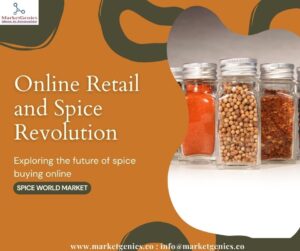Let’s be honest—when you think of spices, the first image that pops up is probably a bustling market. Colors, aromas, a friendly vendor scooping turmeric with a smile. Right?
Well, not anymore.
The way we buy spices has changed drastically. Thanks to e-commerce, that same vibrant masala mix you once picked up from a crowded stall in Delhi or Istanbul is now being added to someone’s cart in Berlin or Chicago—with just a tap. The spice world has moved online, and things are heating up. Let’s see what MarketGenics have to say on the spice industry.

The figures are the firmest base to build upon.
As per MarketGenics, it has been found that the global spices with the seasonings market are valued nearly at USD 24.5 billion and is now expected to exponent at around USD 34.2 billion by 2030, experiencing growth at a CAGR of around 5.7% leading to massive surge of spices in online retail.
Comfort of so many consumers, just a click away i.e., E Commerce together with growing interest in global cuisines and wellness, has driven consumers to explore spices in new ways. Every old home remedy found its way to meds, e.g. using turmeric for inflammation, cinnamon for blood sugar, or cardamom for digestion—spices are no longer just ingredients, they’re lifestyle products.
Okay, selling spices online sounds super cool and all—like, niche brands reaching people all over the world? Love that. But… it’s not all smooth sailing. There’s a bunch of stuff going on behind the scenes that makes things a little tricky.
Selling spices online these days isn’t just about having the freshest turmeric or the fanciest Himalayan salt. It’s about knowing what people really want, what’s trending, and how your brand stacks up against the rest. That’s where MarketGenics come in play like a secret weapon.
MarketGenics helps companies figure out stuff like:
You don’t get only charts and graphs—you get real insights you can use. Like which spices are blowing up in which regions, what people are willing to pay, and how you can tweak your products or website to boost sales.
Also helping you avoid costly mistakes—like launching something nobody’s asking for or messing up your labeling in a market with strict rules.
Bottom line: working with MarketGenics helps you stop guessing and start making smart moves. If you want to stand out in the spice game, especially online, it’s totally worth it.
This question is often asked by many consumers, who once believed locals are now more willing to make purchases just by click, shall we call it a “Click to Cart” strategy? Let us segregate how far has E Commerce led this business
Earlier, access to certain regional spices was limited to local shops or import stores. But today, an artisan spice blender in Morocco can sell rasel hanout to a customer in Sydney through platforms like Amazon, Alibaba, Etsy, or independent D2C websites. This global reach is empowering small-scale producers and leveling the playing field increasing competition beyond.
Lately many spice brands are bypassing traditional retail chains and selling directly to consumers online. This allows,
D2C models also enable better feedback loops, allowing companies to refine products and build stronger relationships with loyal customers.
The digital spice aisle is no longer limited to single-jar purchases. Many online retailers now offer:
This personalization drives repeat purchases and helps brands stand out in a competitive space.
So, there’s been an interesting shift in how folks are buying their spices lately—especially online. It’s not just about flavor anymore (though let’s be real, that still matters). Here’s what’s really going on:
E-commerce has totally changed the game for the spice world. What used to be super local and limited is now, well, everywhere. You can buy Moroccan saffron or Korean gochugaru from your couch. Pretty wild, right?
With stuff like personalized shopping, transparent sourcing, and even AI suggesting what spice you might need next (creepy but cool), this old-school industry is getting a serious digital glow-up.
For spice brands—whether they’re tiny kitchen startups or big-time players—this whole shift is kind of a mix of “yay” and “yikes.” It’s full of opportunities, but yeah, also a bunch of pressure. They’ll need to stay fresh (literally), keep it real, and keep up with what today’s online shoppers care about. The spice trade might be ancient, but in the age of clicks and scrolls? It’s spicier than ever.
MarketGenics reports can help spice companies by delivering in-depth consumer insights, market trends, and sustainability analysis to drive strategic growth. Through data-driven research, it helps brands align with evolving demands for authenticity, traceability, and eco-conscious practices.

MarketGenics India is a MRSI certified company.
Send us your resume at
info@marketgenics.co
© 2025 MarketGenics India Pvt Ltd.; All rights reserved